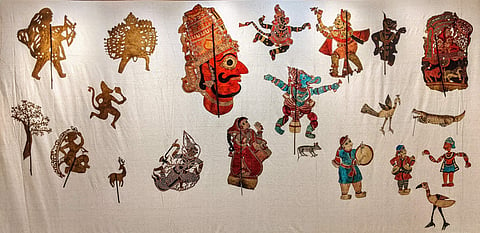
- LIFESTYLE
- FASHION
- FOOD
- ENTERTAINMENT
- EVENTS
- CULTURE
- VIDEOS
- WEB STORIES
- GALLERIES
- GADGETS
- CAR & BIKE
- SOCIETY
- TRAVEL
- NORTH EAST
- INDULGE CONNECT

In the 15th century, ruler Sri Krishnadevaraya of the Vijayanagar Empire introduced leather puppetry to spread tales from mythology. But he wouldn’t have envisioned that just six centuries later, the artform would be on the verge of being forgotten. However, there are folk artists and artists such as professor MJ Kamalakshmi, vice president, Karnataka Chitrakala Parishath (KCP) who are striving towards preserving this ancient art form. In December last year, Kamalakshmi opened an exhibition of leather puppets, titled Reflection - The Ramayana, at Art Houz gallery.
The exhibition features 45 pieces that signify different stories from the Ramayana such as the procession after Sita Kalyana (Sita’s marriage), Lord Rama’s student days where he is seen learning from the great teacher Vishwamitra, and scenes depicting his childhood with his mother Kausalya. The artworks are a mix of photographs of leather puppets and pieces that are designed by Kamalakshmi’s students. “We have tried to capture the gist of Ramayana in this show. The pieces created by us are inspired by some of the original puppets that are on display at KCP. For example, the Pushpaka Vimana (the flying chariot of Ravana) and Lanka Dahana (burning of the Lanka) are made by us using our imagination although these are not part of the original puppets at KCP,” explains the artist. The pieces are shadow puppets that are flat figures cut out of leather and then treated till they are translucent.
The characters are then drawn on them and the cutouts are punched with dots, lines and holes, and painted with different colours. To prevent the puppets from bending, a thin strip of bamboo is fixed vertically on either side to suppor t it. T his ancient tradition is among the dying arts of the country. “These puppets were tools of mass media to take the message of ethics and principles to the common man. Today, we need to pass on this tradition to the next generation so that they can use this art form to tell modern stories,” signs off Kamalakshmi.
Until January 9. At Art Houz, Vasanthnagar
ayeshatabassum@ newindianexpress.com
@aishatax